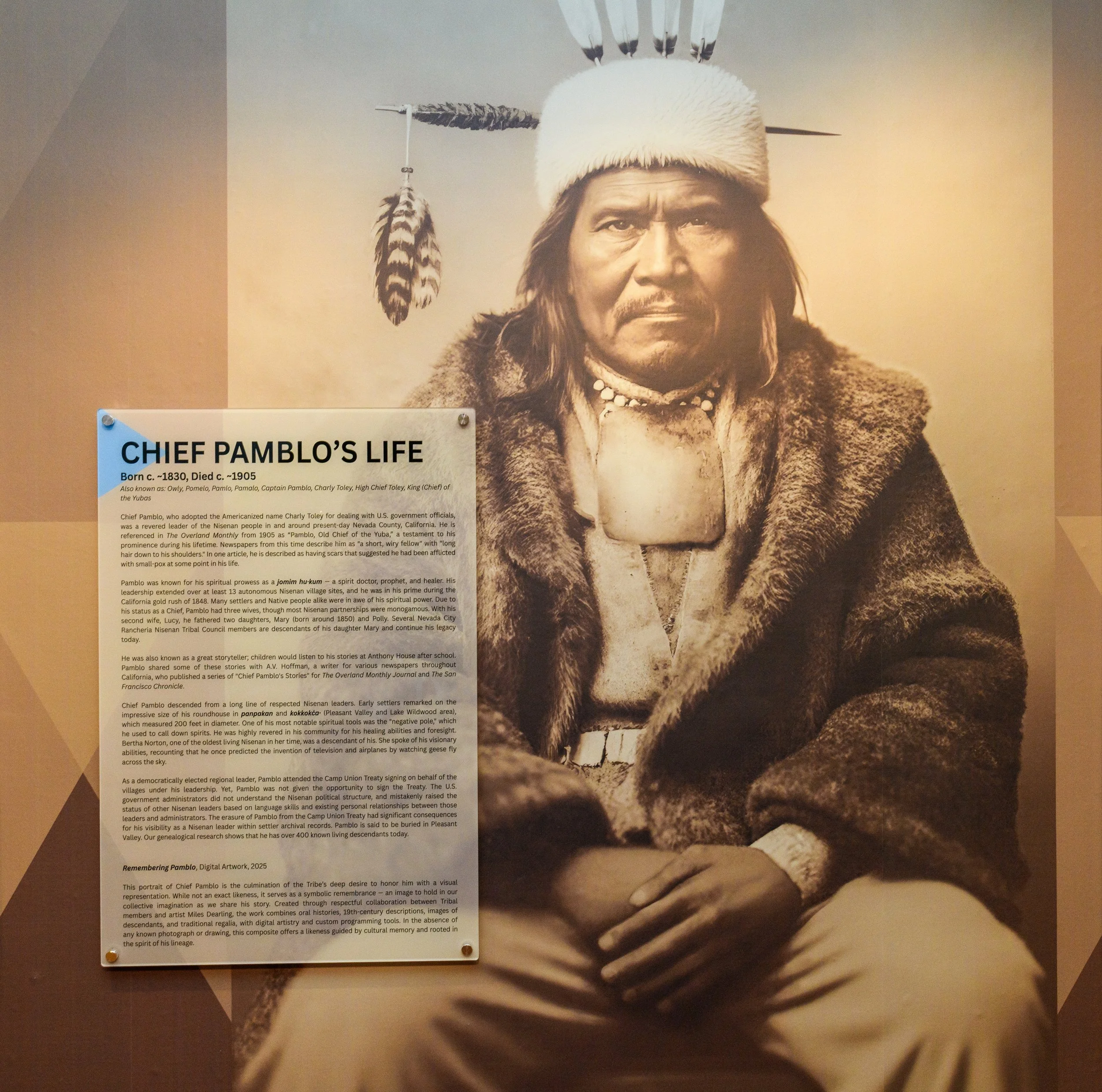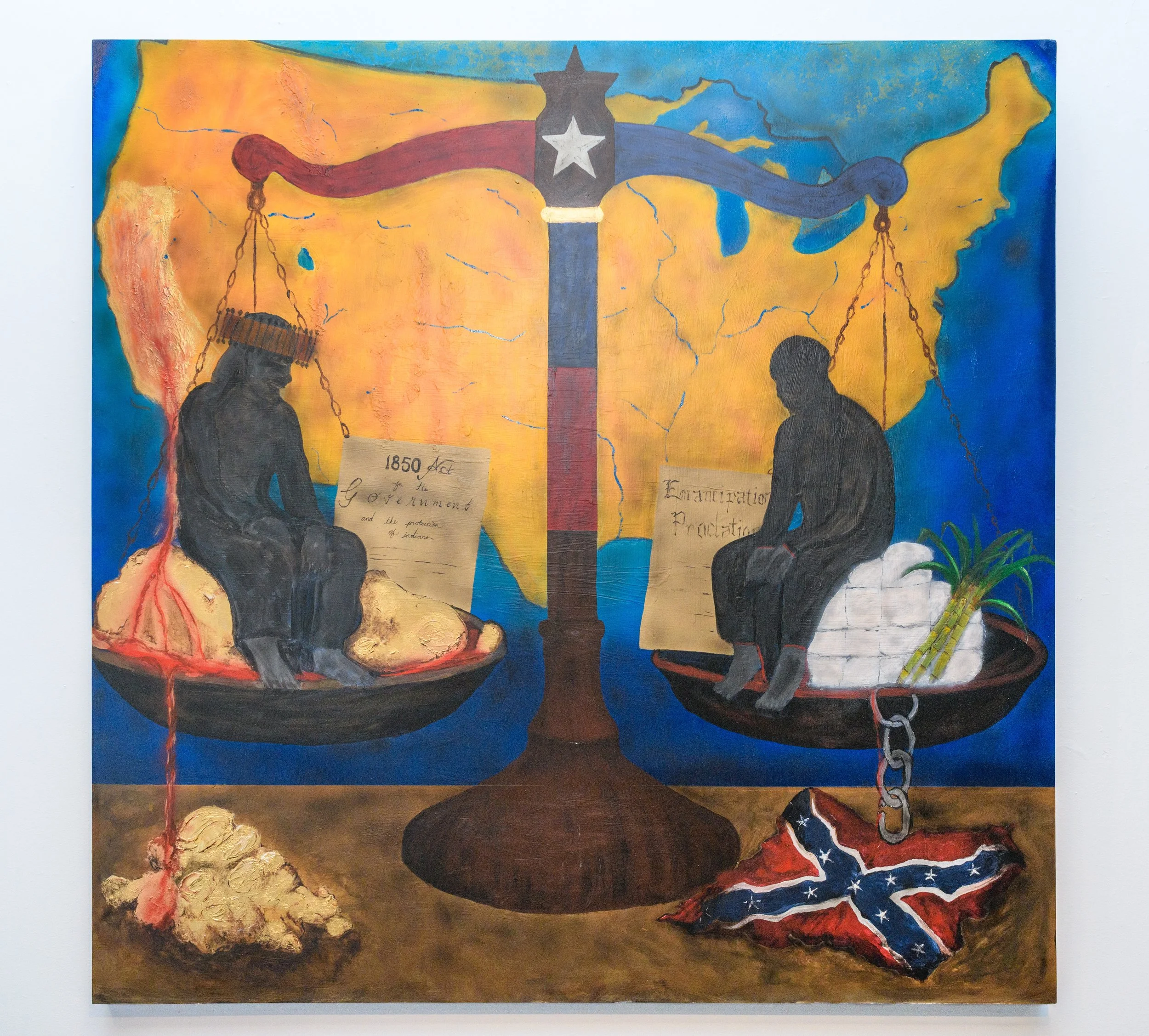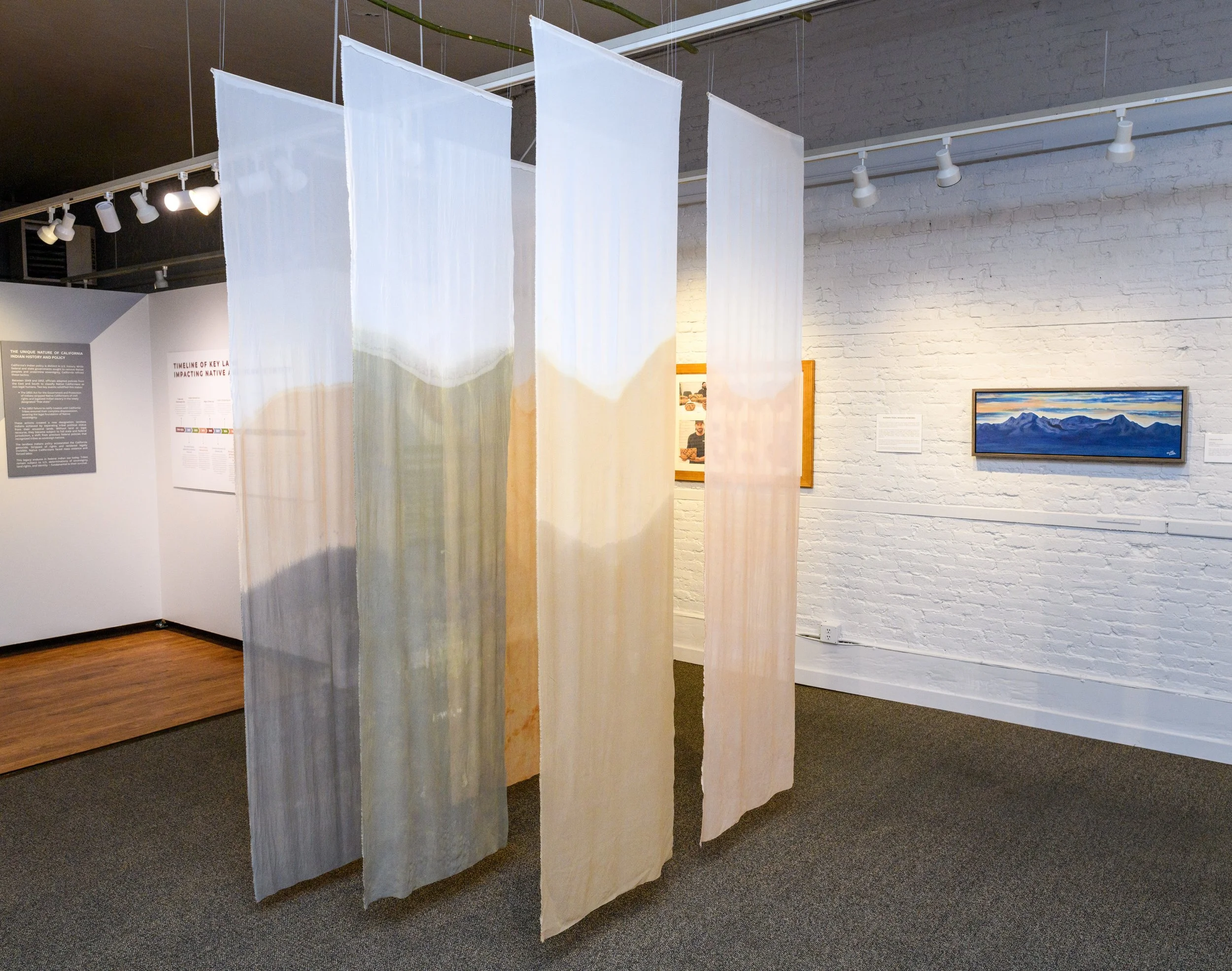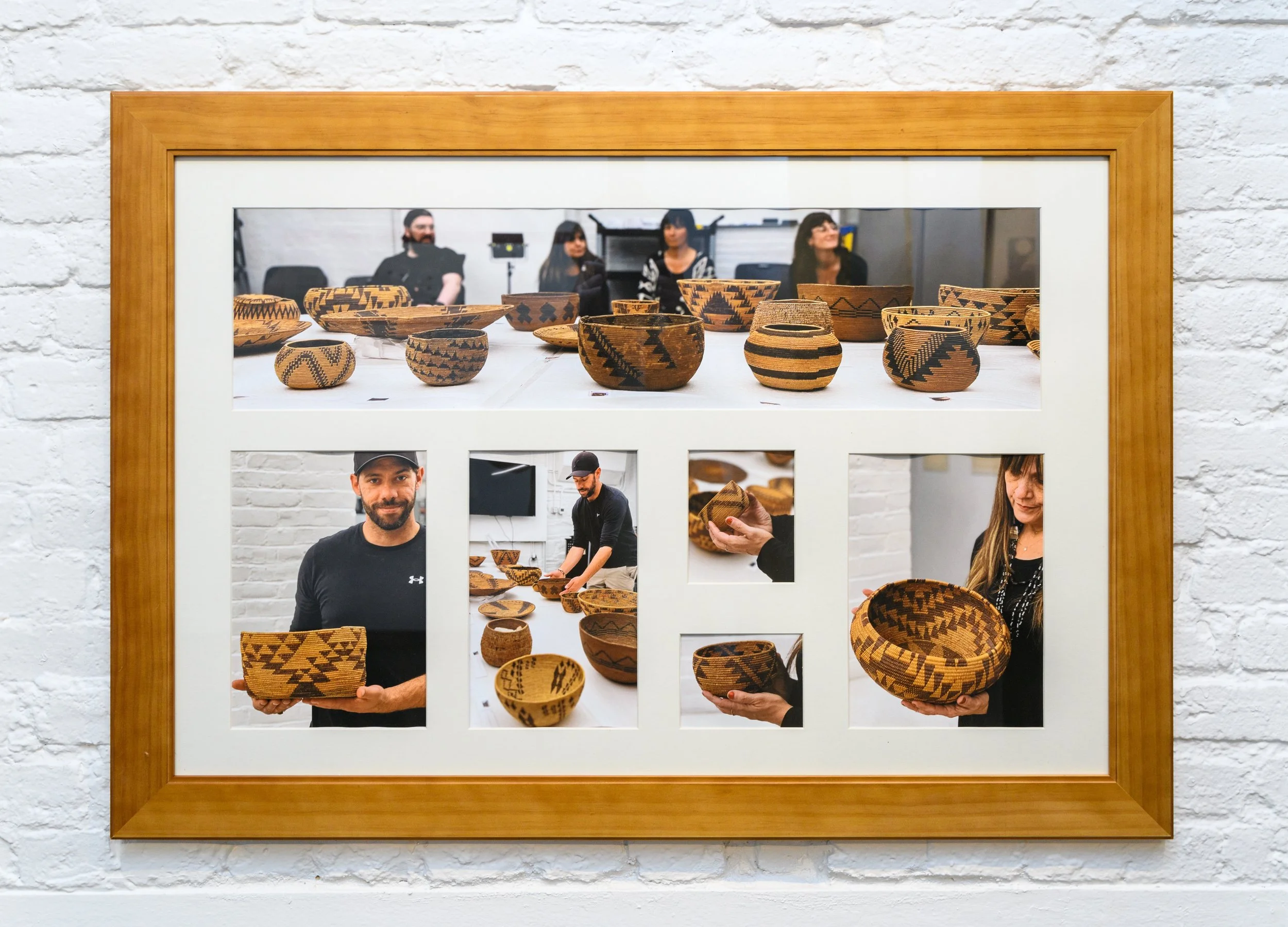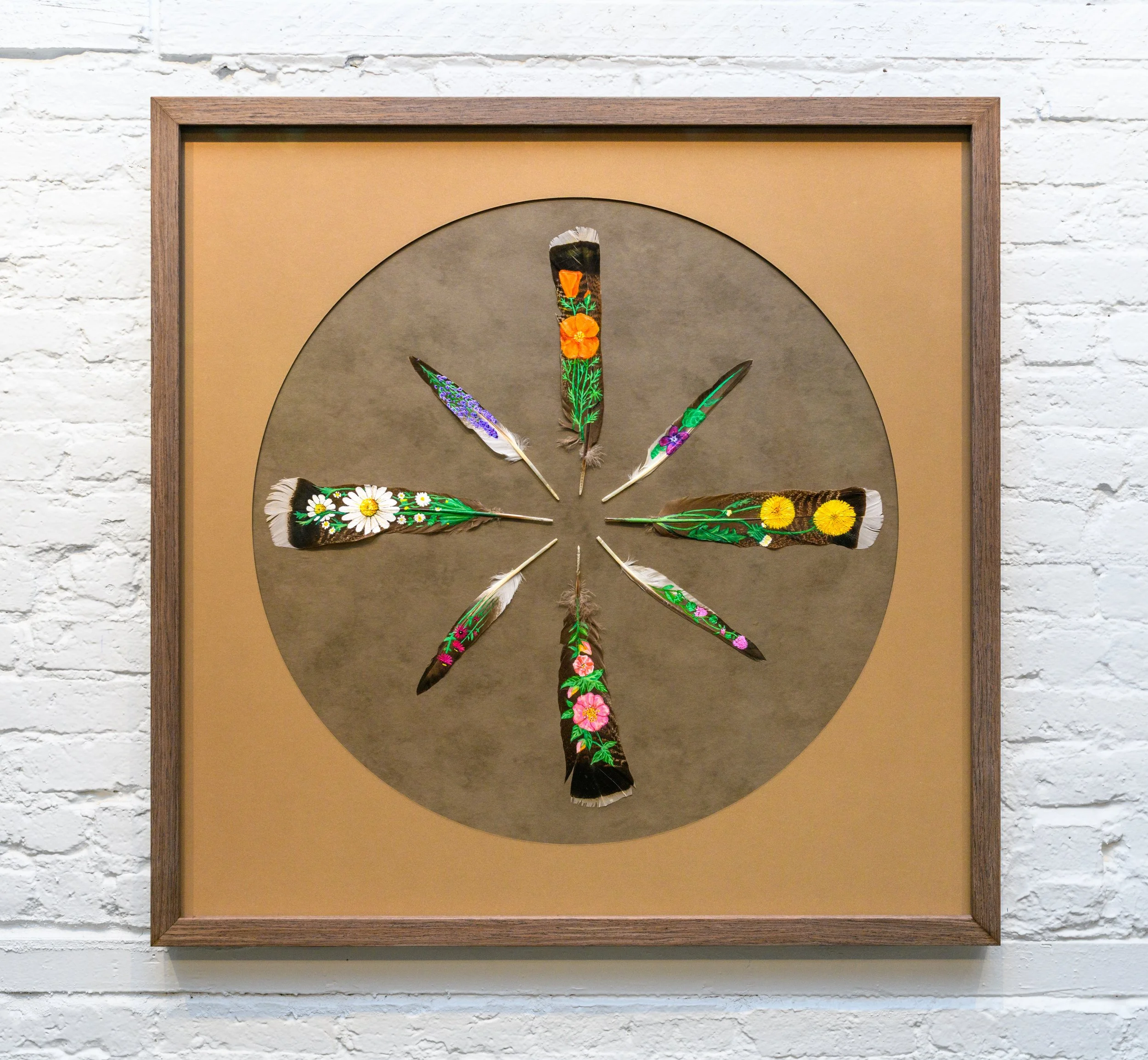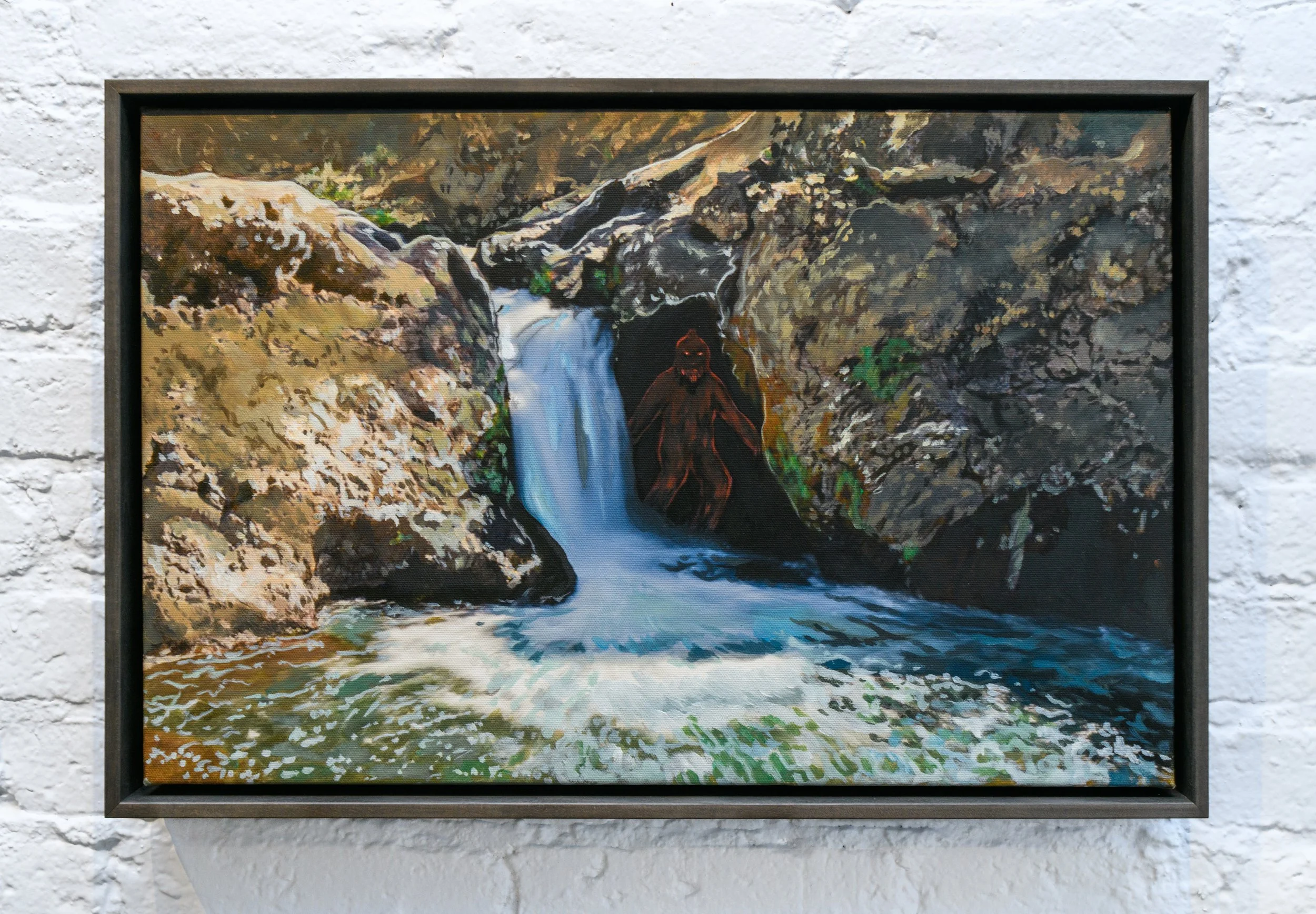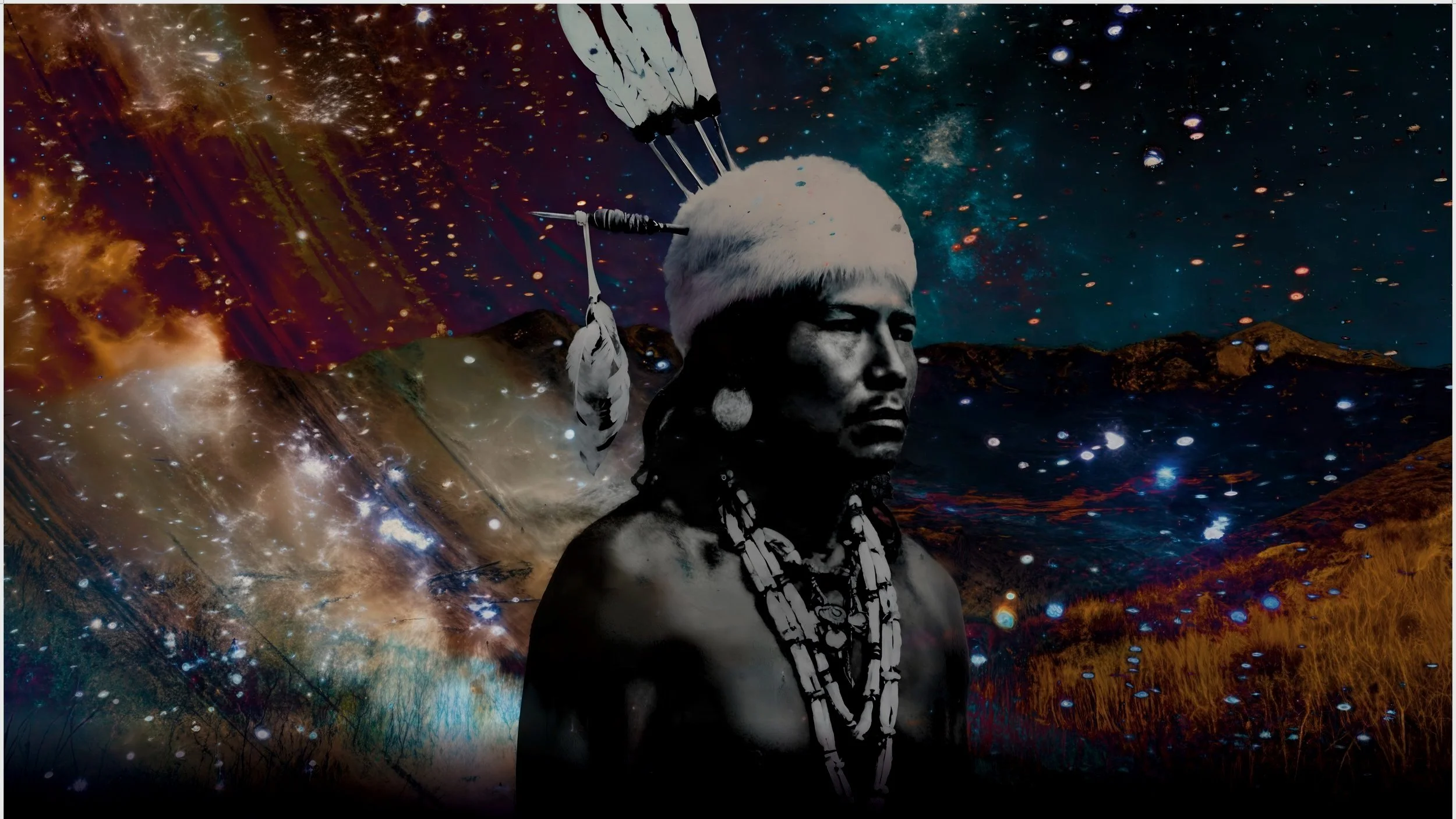
PAMBLO
Remembering a Forgotten Leader
A Changed Land, A Changing Culture
A Changed Land, A Changing Culture
Remembering a Forgotten Leader
PAMBLO
Visibility Through Art 2025
October 2025 - October 2026
PAMBLO: Remembering a Forgotten Leader is the seventh exhibit showing at ‘Uba Seo: Nisenan Arts and Culture, a groundbreaking exhibition which honors the life and legacy of Chief Pamblo (also known as Owly, Pamblo, or Charly Toley), a revered Nisenan leader, healer, and prophet who lived from around 1830 to 1905.
The exhibition is part of CHIRP’s Visibility Through Art (VTA) initiative, which brings together artists and Tribal Culture Bearers to raise public awareness about the Nevada City Rancheria Nisenan Tribe.
Through educational panels, never-before-seen images, and significant cultural artifacts, visitors will learn about the Nisenan people’s enduring history before colonization, through the Gold Rush, and into the present. The exhibit also features contemporary artworks and a striking textile installation created by living Tribal members, descendants of Pamblo, and collaborating artists, celebrating cultural memory and resilience.
The exhibition was funded in part by the Decolonizing Wealth Project: California Truth and Healing Fund (CATH), which supports California Native American tribes and Native-led organizations advancing truth, healing, and repair across the state.
ORAL HISTORY, RESEARCH, AND RESTORATION
Because Indigenous history in California is marked by systematic erasure and fragmented records, reconstructing Pamblo’s story has required extensive archival research, oral history, and Cultural interpretation. Over the last 18 months, CHIRP’s team collaborated with Tribal members, researchers, archivists, and artists to gather photographs, news articles, and historical references. The exhibit includes a comprehensive timeline of events that shaped Indigenous life and identity during Pamblo’s lifetime, alongside artifacts, legal documents, and rare illustrations digitized from archives.
Pamblo’s story is both extraordinary and emblematic of the challenges faced by California’s Native Peoples. He led his community through one of the most devastating eras of Cultural upheaval, the California gold rush, while carrying forward traditional knowledge as a spirit doctor, prophet, healer, and storyteller.
EXHIBITING
Nevada City Rancheria Nisenan Tribal Member Artists: Shelly Covert, Lorena Davis, Sarah Thomas, Cindy Buero, Debra McBrien, Saxon Thomas, Brittney Depew, Heidi Noel
Native | Nisenan Special Guest Artists: Tiffany Adams
Participating Artists: Maile Claire, Mekdela Maskal, Bishop Randall, FluxFlow Glass, and Miles Dearling
Gallery & Opening Night
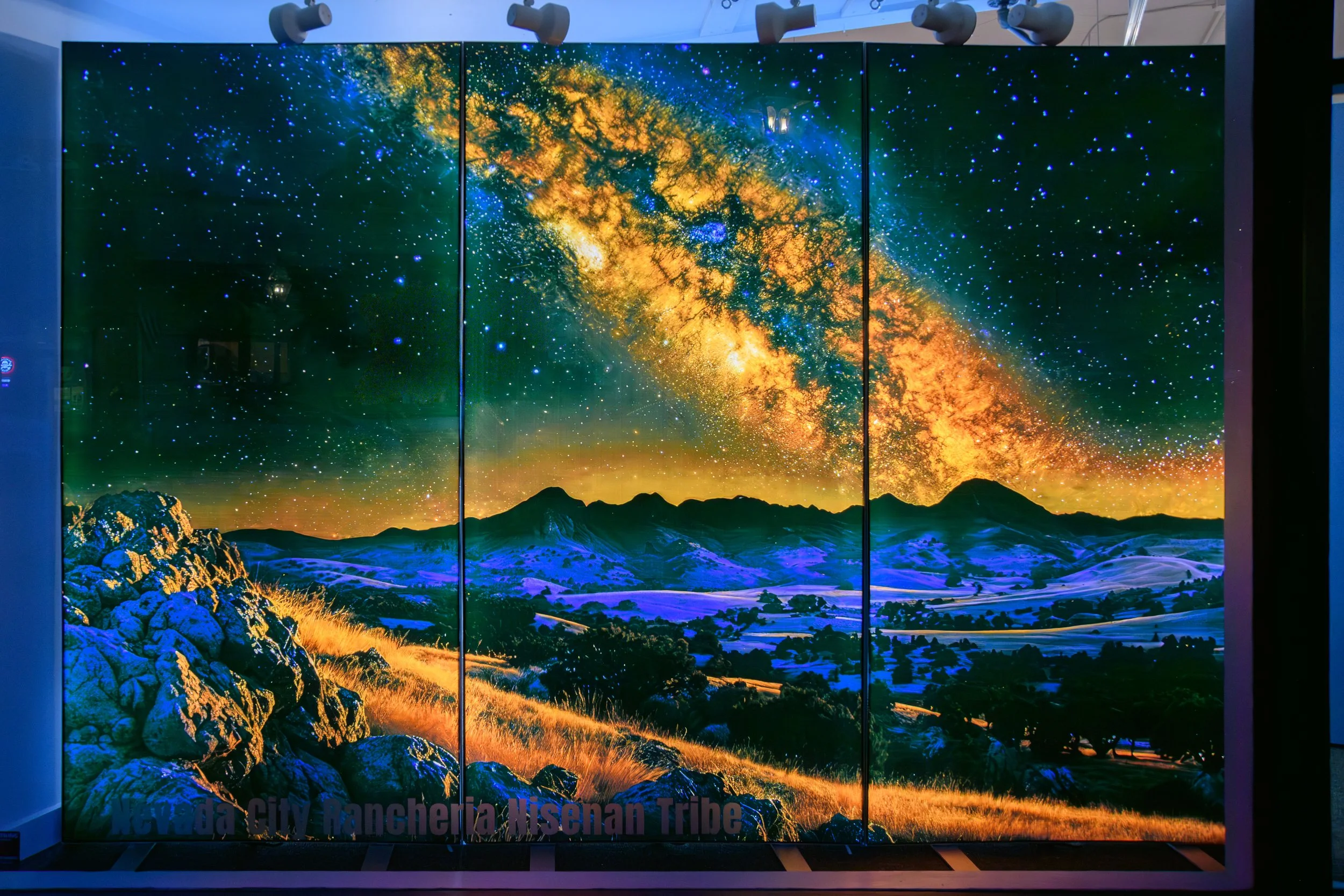
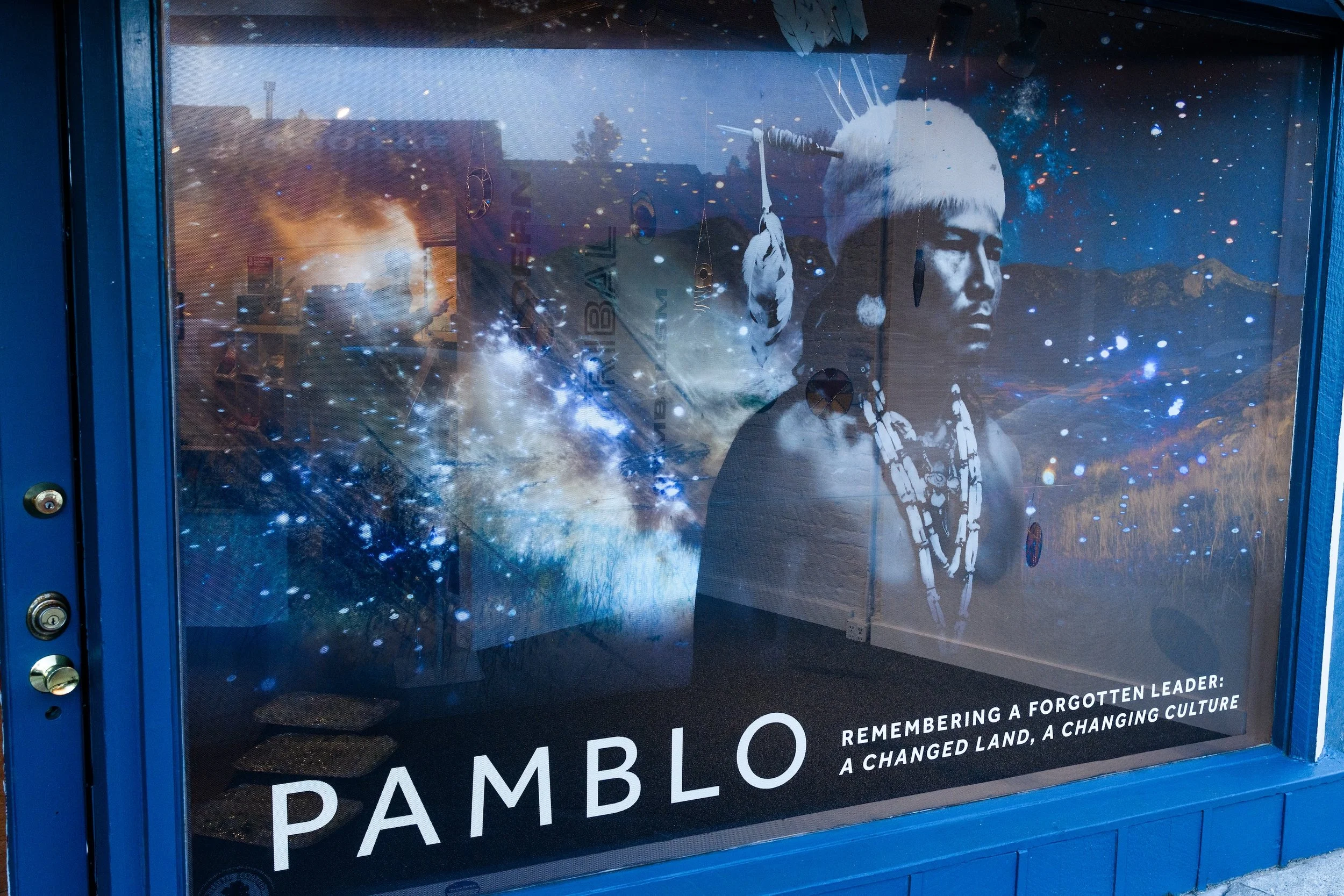


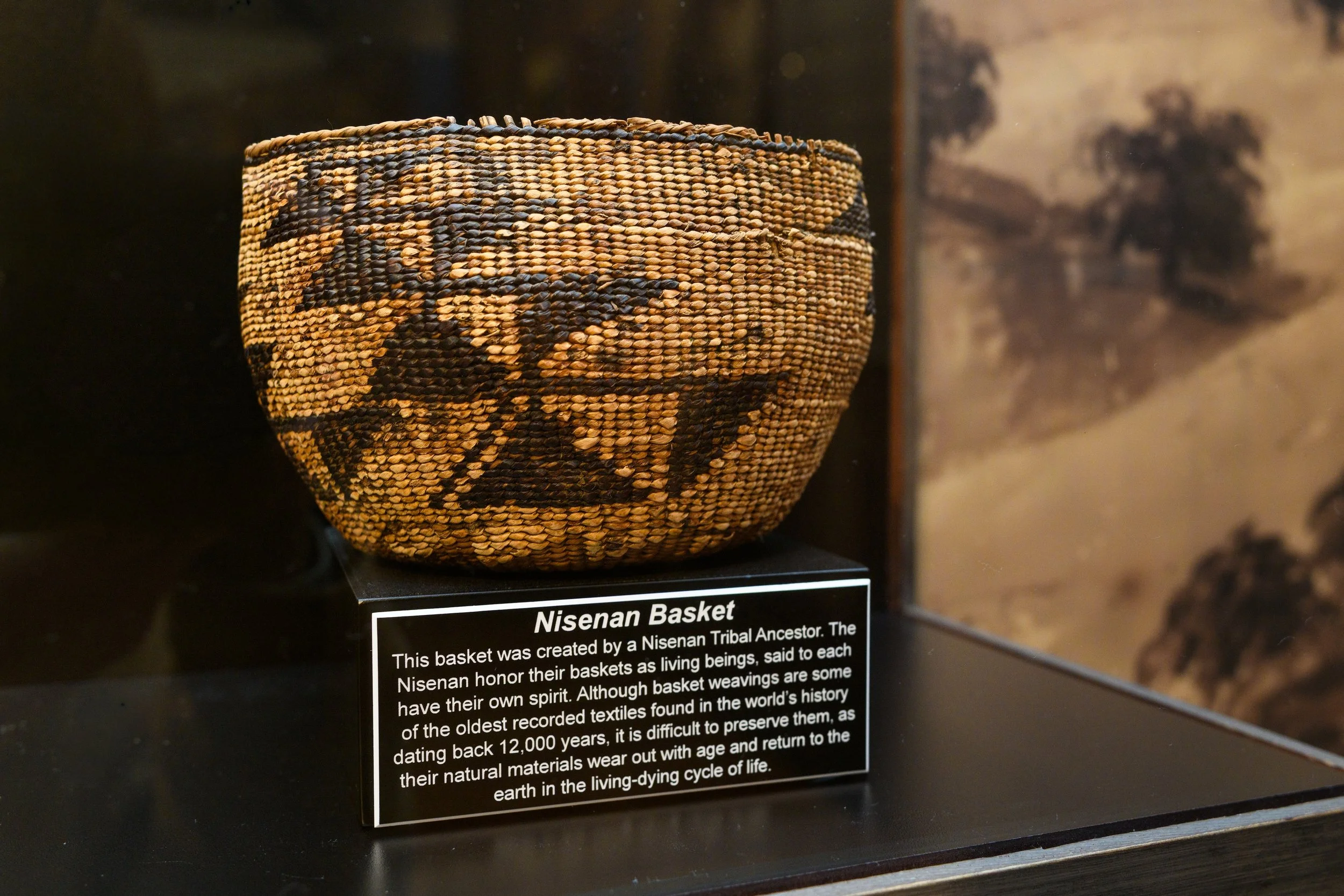

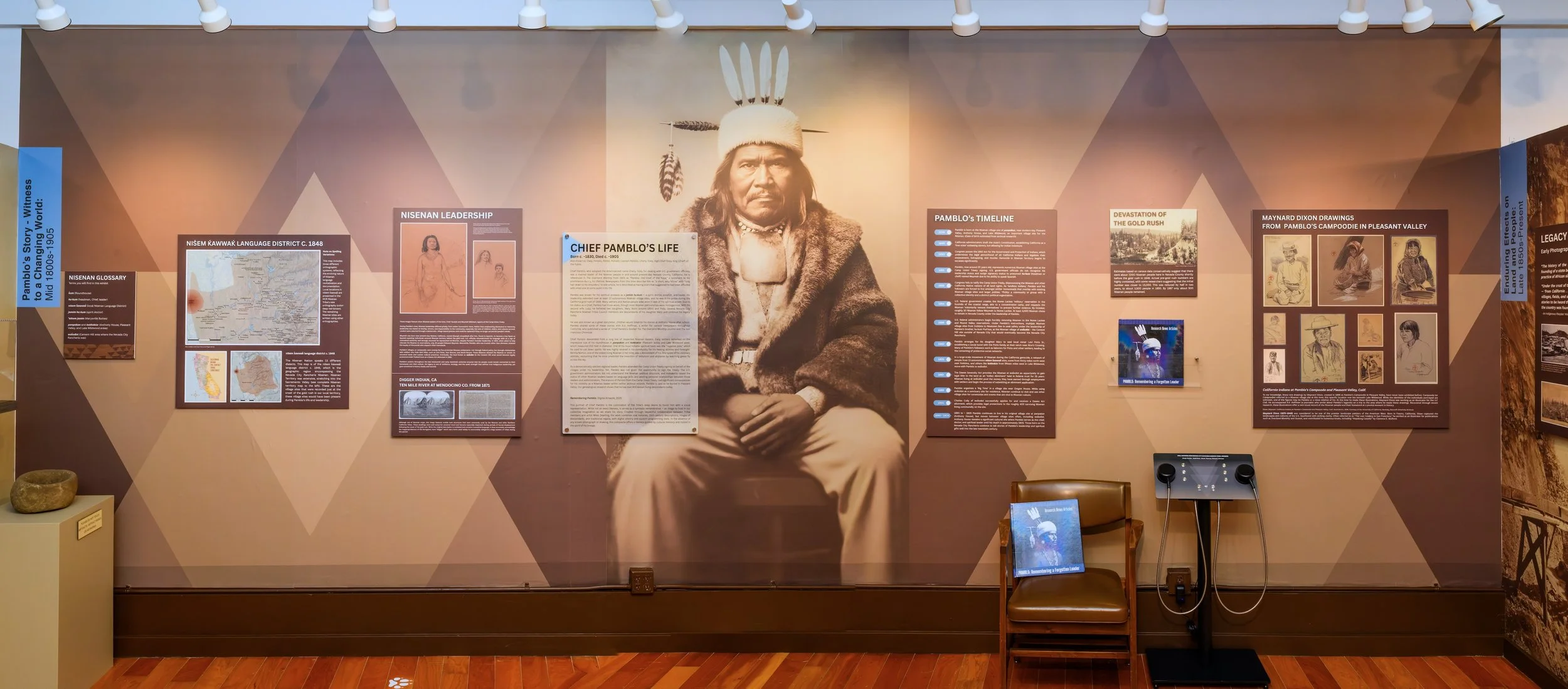

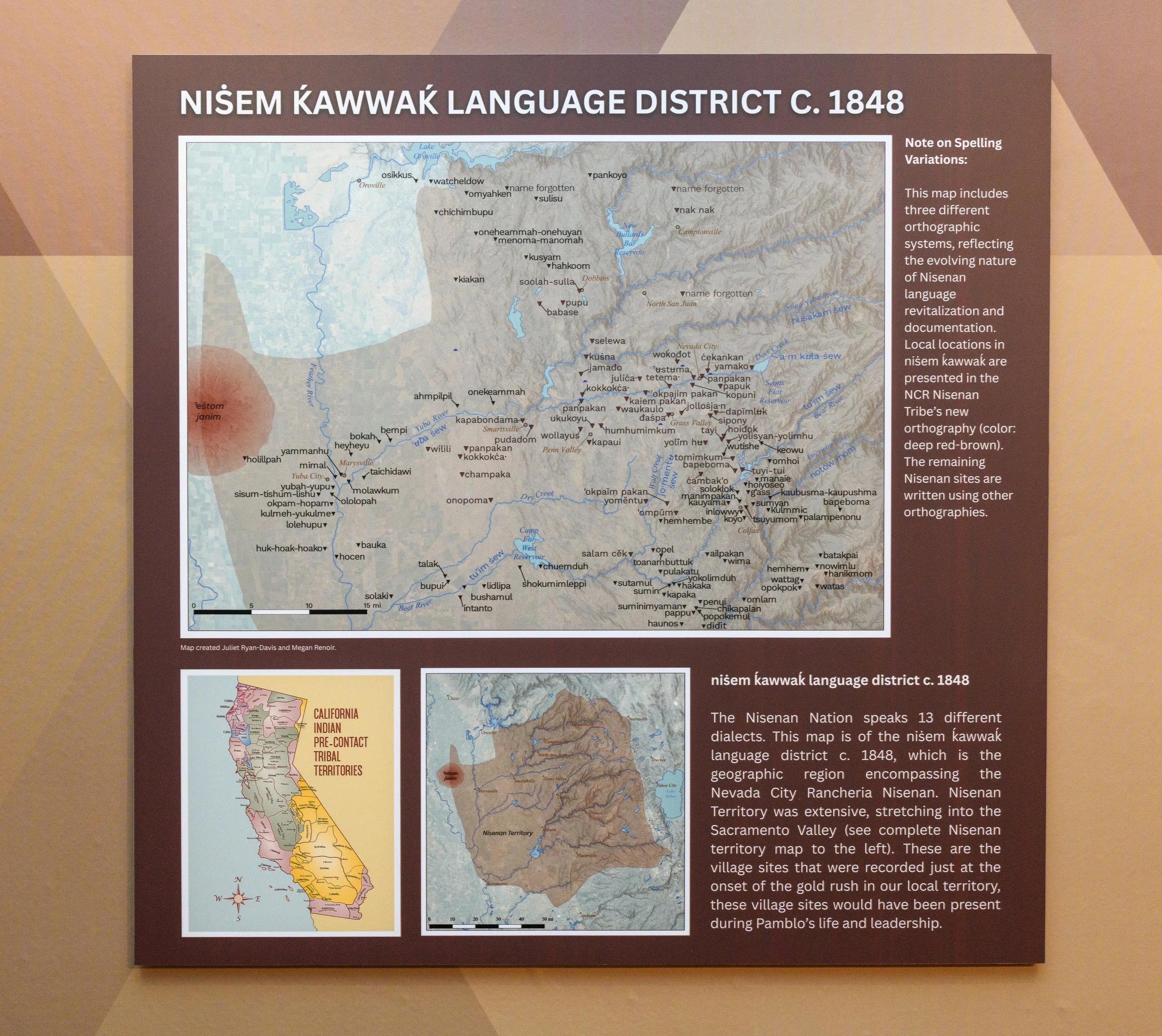
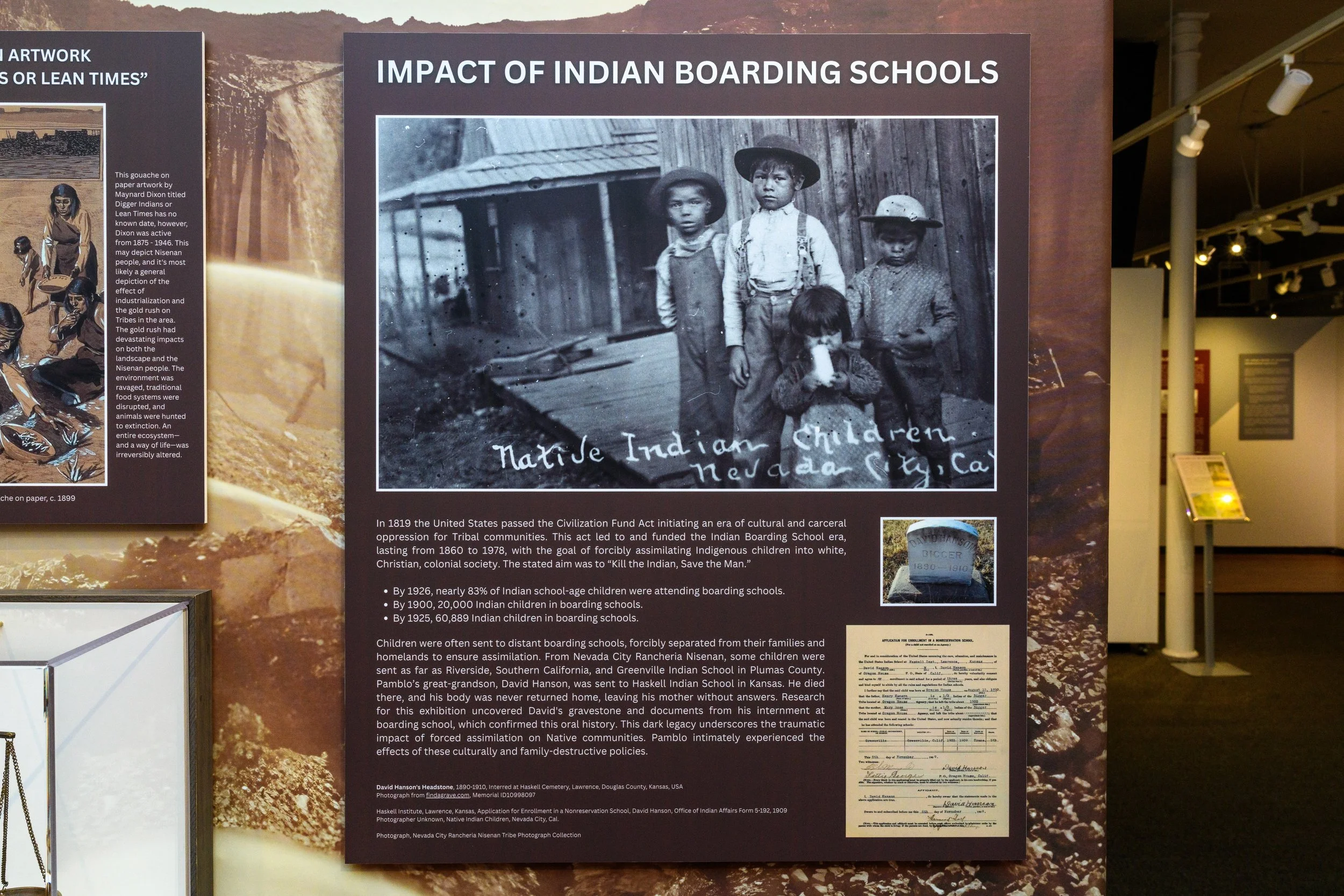
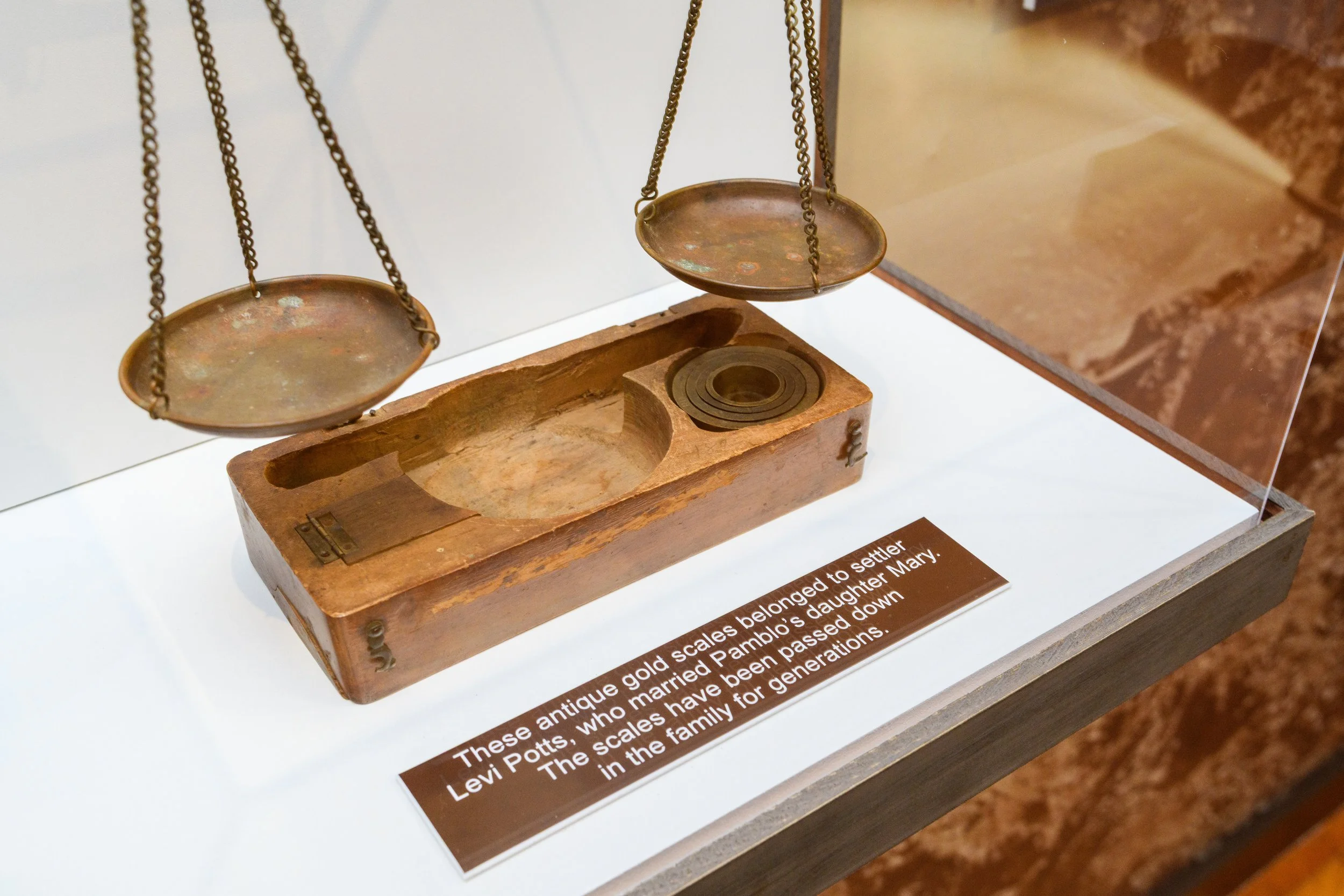



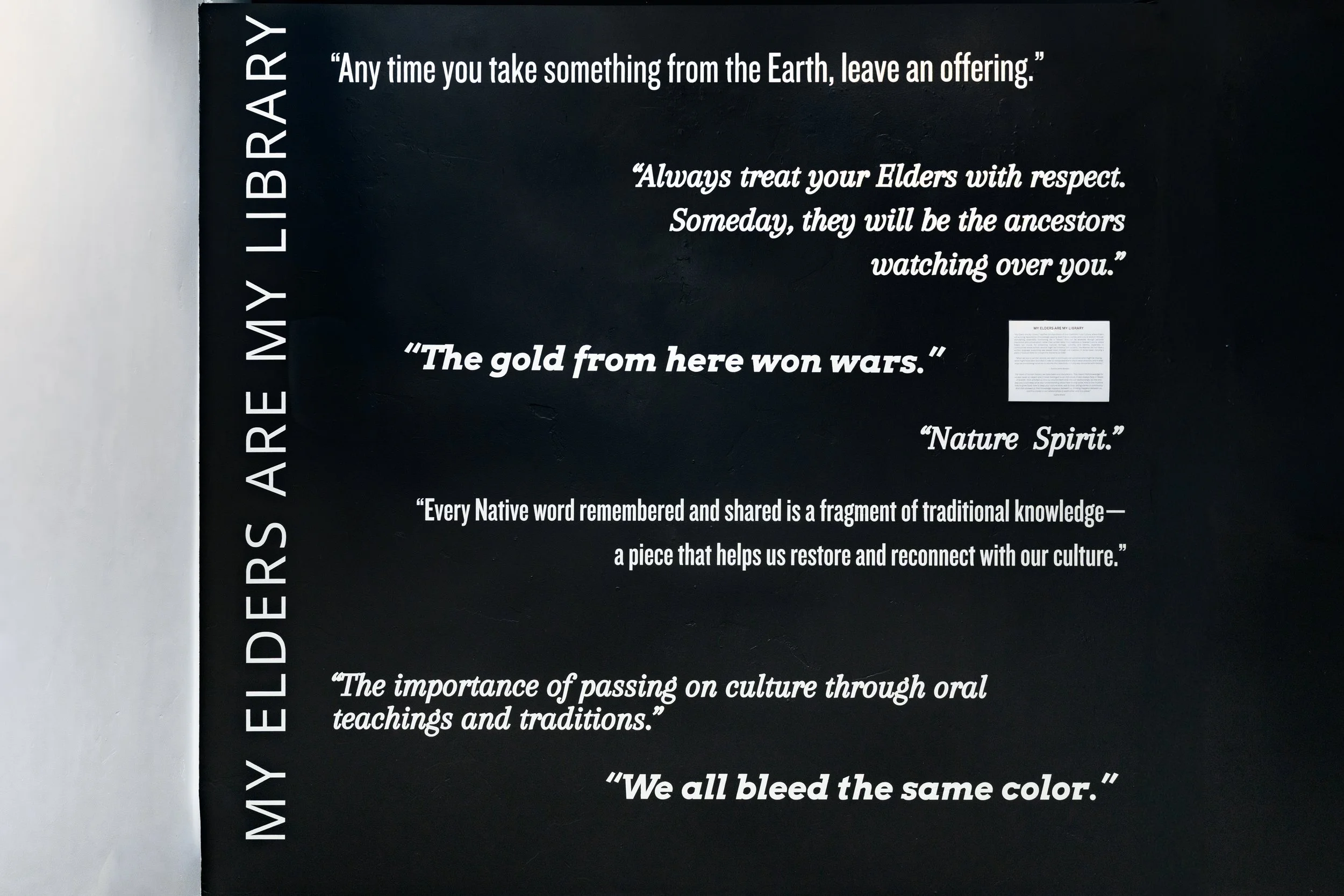



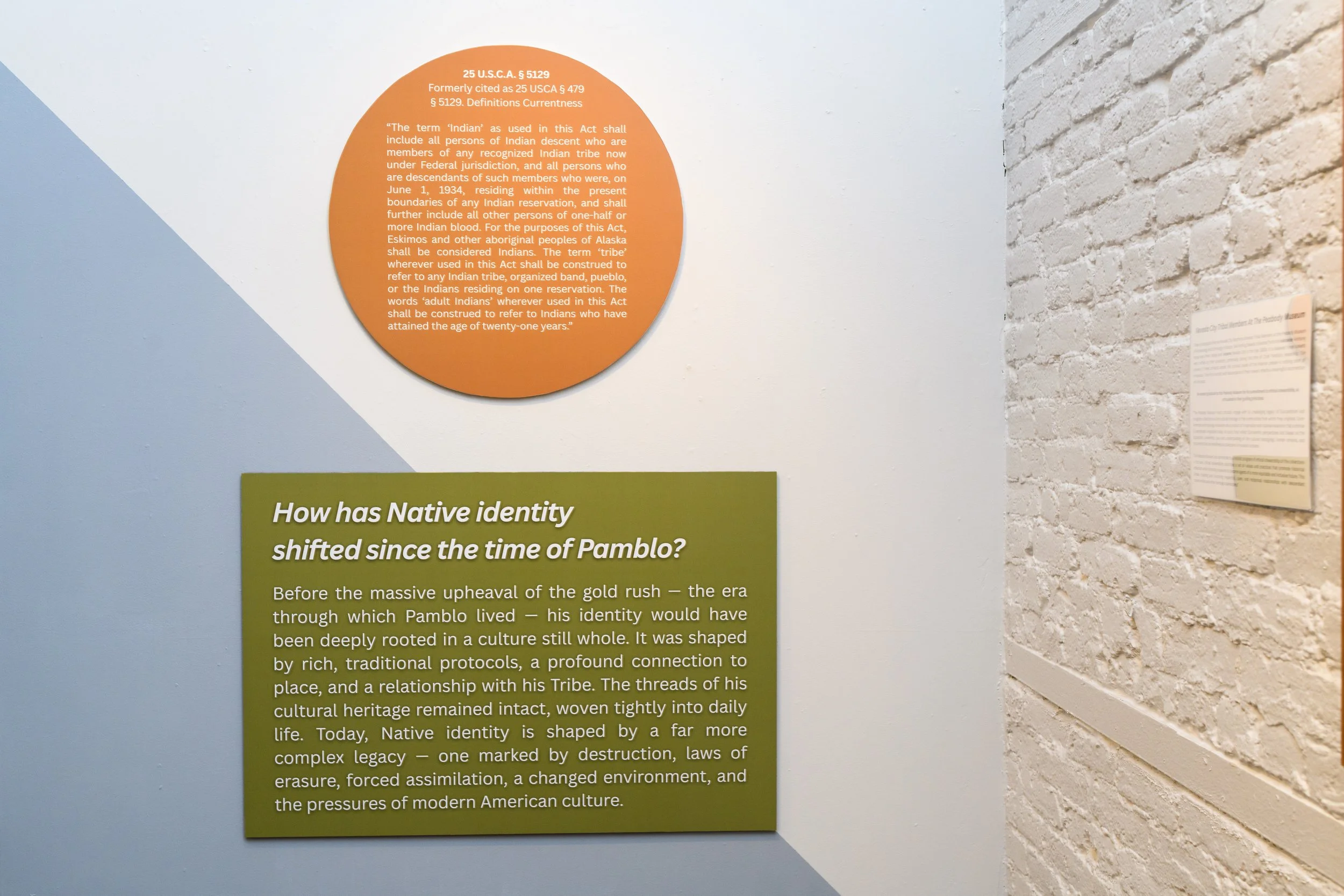








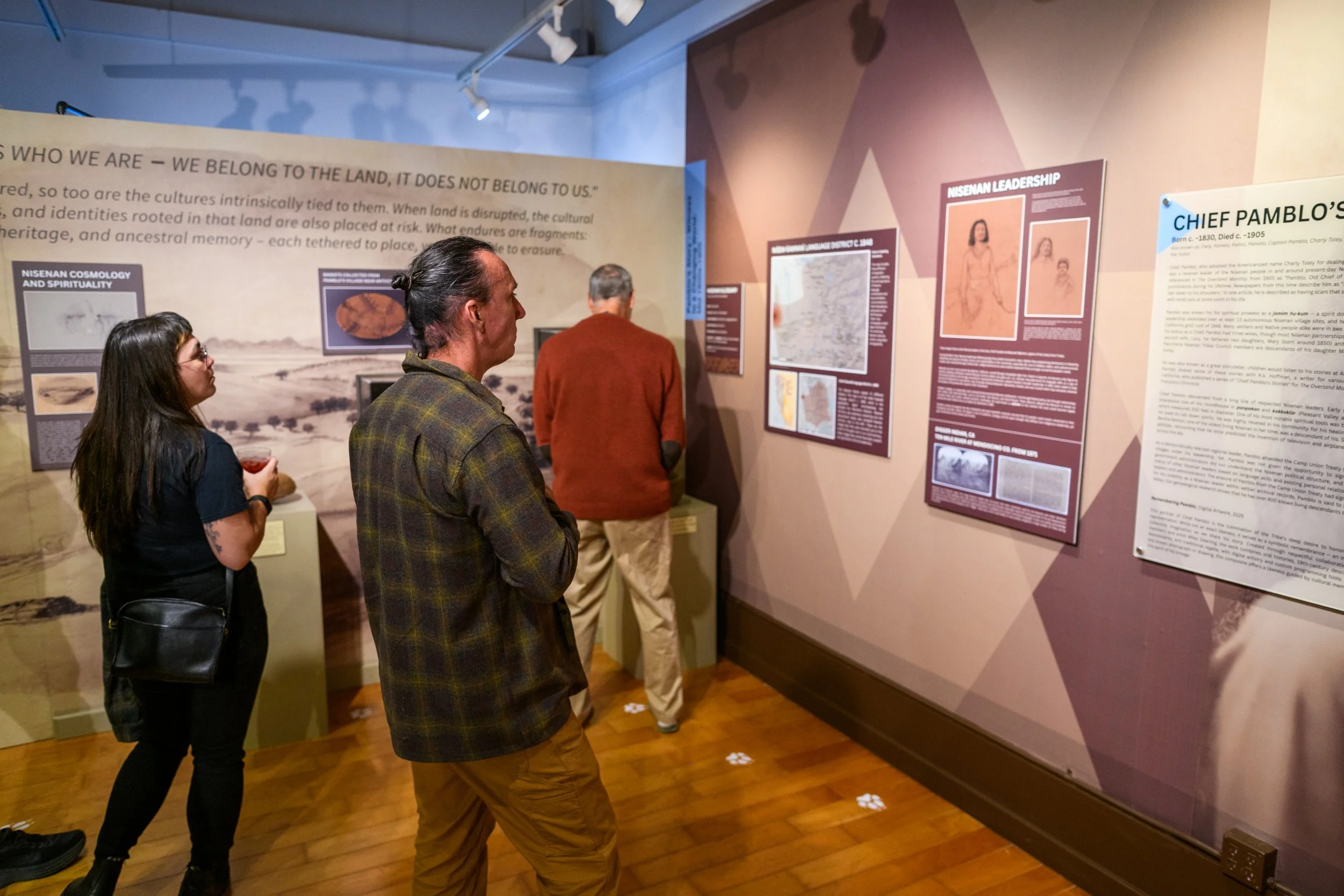


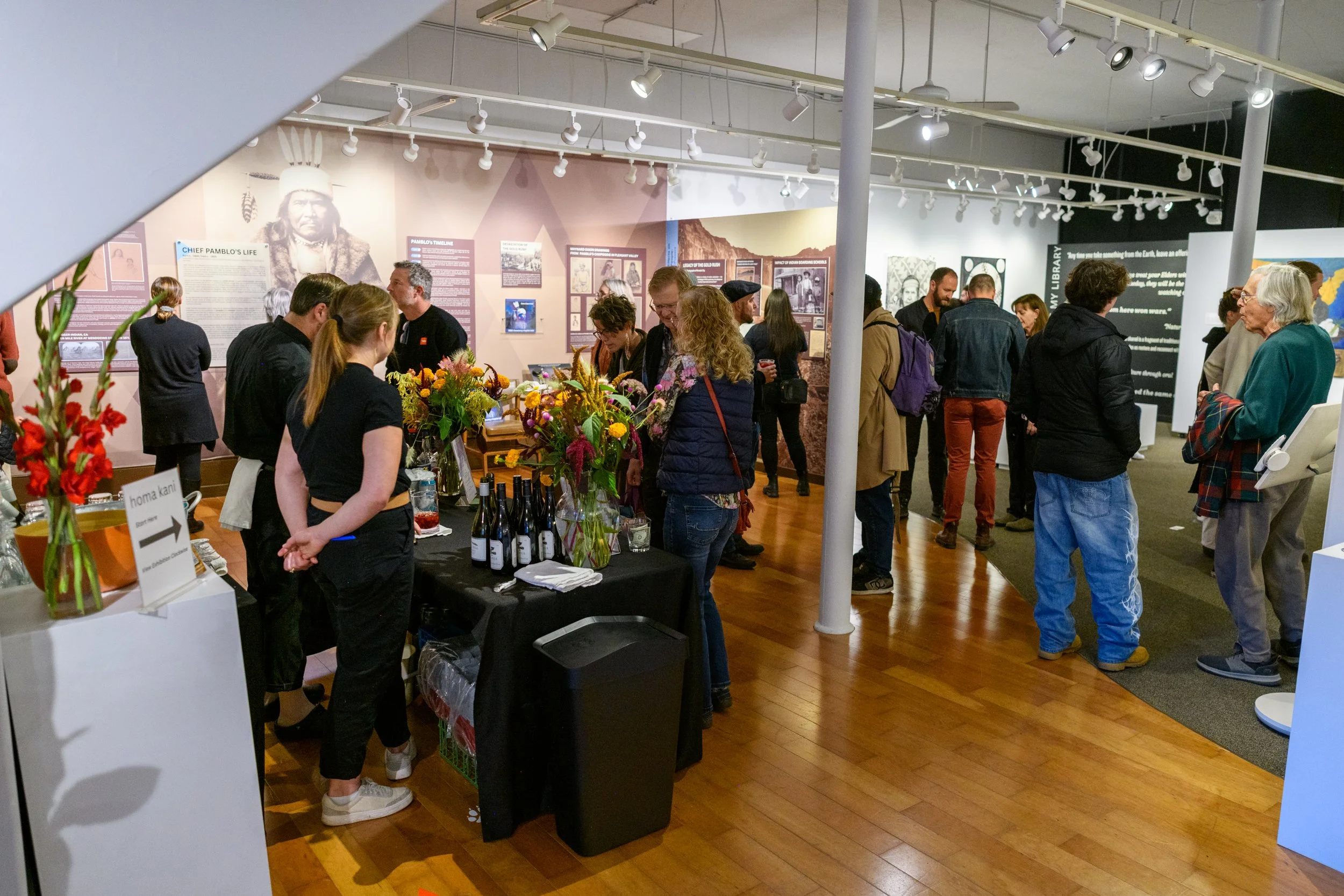
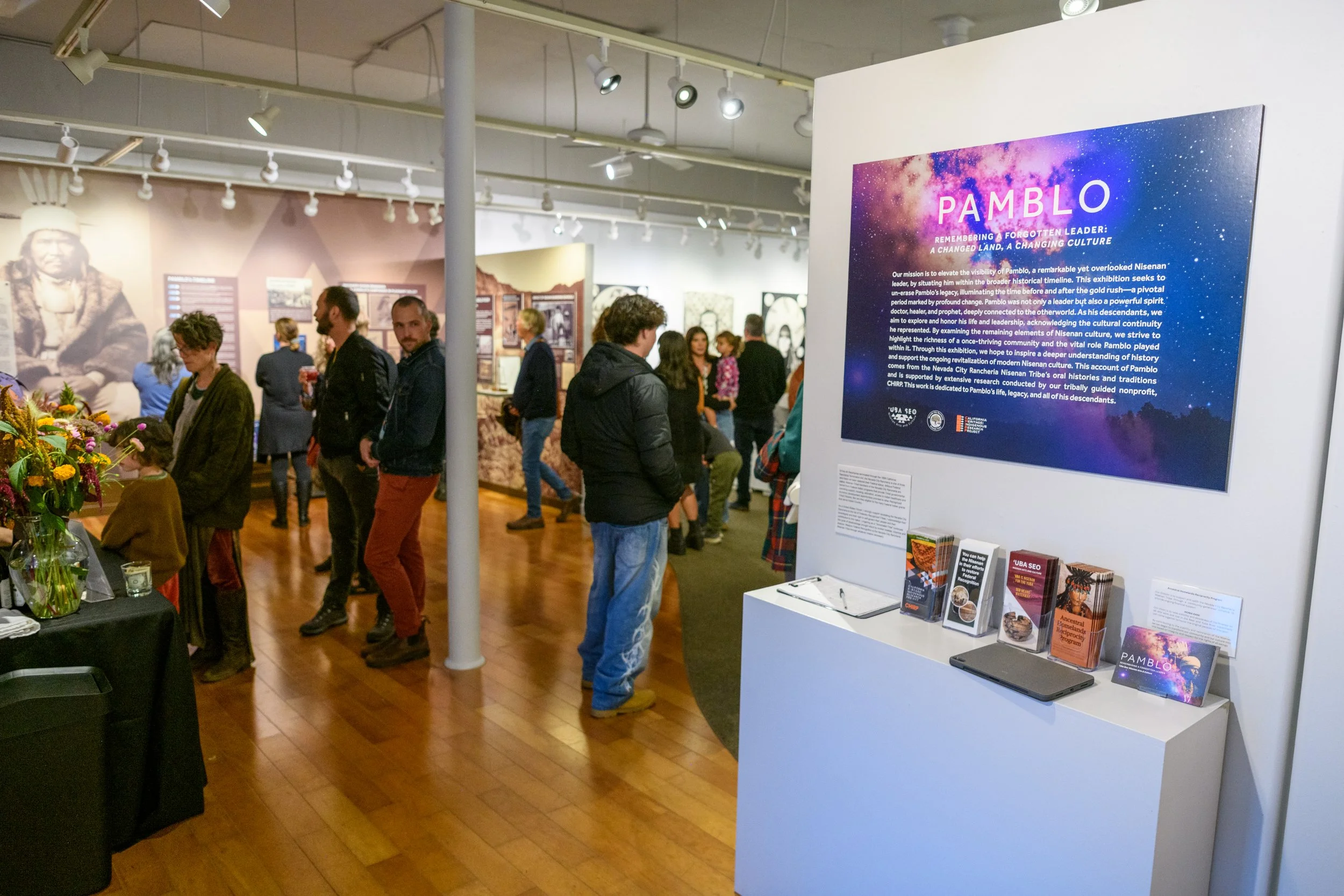

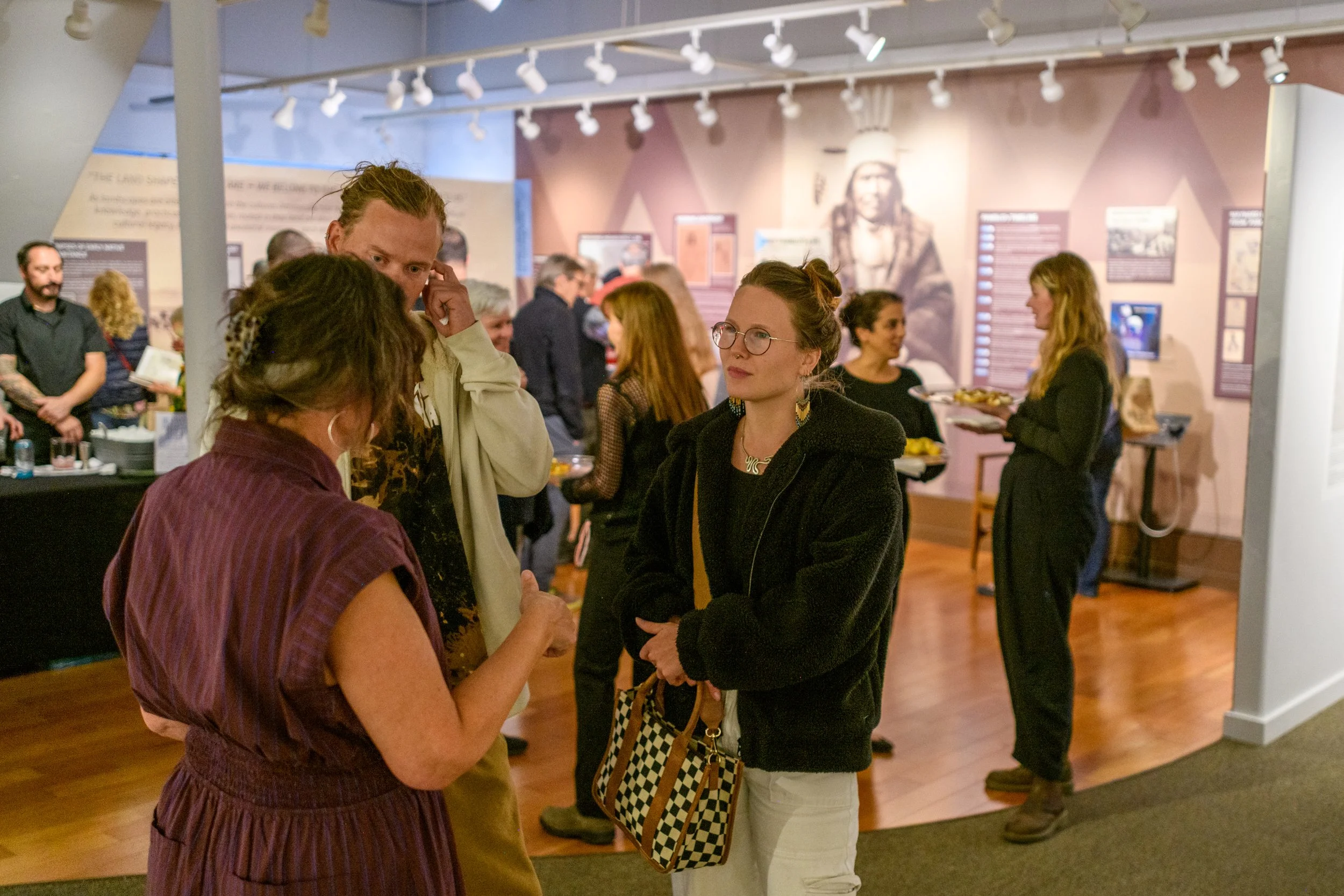





Special Thanks to Event & Art Photographer Kian Berreman
Gallery of Artworks
niṡem ḱawwaḱ Bishop Randall Material: Glass Instagram: @Bishop3333 ________________________________________ A recurring question in my work is, “Where does culture arise—from the land or its people?” Culture is the accumulation of observations that become stories, rituals, and ways of life shaped by place. This map reflects more than geography—it embodies the spirit of land and people, their memories and dreams, both tangible and ineffable, across past, present, and future. It asks: where have we been, where are we now, where are we headed? Clear glass, at first transparent, reveals distortions and layers when examined closely. So too does a place’s history, exposing complex truths about its people and environment. Glass —fragile, malleable, and transparent — mirrors cultural exchange and transformation, while also symbolizing the invisibility forced upon the original people of this land. How do we learn from the past, honor what has been taken, and, as newcomers, respectfully become part of it? May this map invite reflection and offer pathways to reimagine relationships with the land and its first inhabitants — finding our place through the practice of place. The territory encompassed by this glass artwork is the territory that fell under Pamblo’s leadership in the 1850's.
Remembering Pamblo, Digital Artwork, 2025 ________________________________________ This portrait of Chief Pamblo is the culmination of the Tribe’s deep desire to honor him with a visual representation. While not an exact likeness, it serves as a symbolic remembrance — an image to hold in our collective imagination as we share his story. Created through respectful collaboration between Tribal members and artist Miles Dearling, the work combines oral histories, 19th-century descriptions, images of descendants, and traditional regalia, with digital artistry and custom programming tools. In the absence of any known photograph or drawing, this composite offers a likeness guided by cultural memory and rooted in the spirit of his lineage.
Honoring Descendants of Pamblo Dutch Rose, Ginger (Rose) Covert, & Shelly Covert Maile Claire, junipertreeoflife.com Graphite and Ink on Clayboard ________________________________________ These three imaginal portraits were always envisioned as a series. The artworks were created by Visibility Through Art (VTA) participant artist Maile Claire, in collaboration with the Nevada City Rancheria Nisenan Tribe. The series began in 2022 with a portrait of Tribal Spokesperson Shelly Covert, and expanded in 2024 with the addition of Ginger Covert’s portrait, the final portrait of Dutch Rose was completed in 2025. Dutch was an informal leader, peacemaker, and friend to many, during a time of great change, fragmentation and cultural invisibility. Dutch played a central role in the succession of formal and informal leadership from the 1850s to the present. His earnest and compassionate leadership integrated different strands of surviving Nisenan kinship and culture. Following the passing of honored elder Ginger Covert at the end of 2024, CHIRP and the Tribe were moved to complete the series with Dutch in 2025 as a tribute to her memory and the legacy she carried forward on behalf of forgotten Nisenan headman Pamblo — informing Nisenan culture, tradition, and leadership. Each artwork reimagines these Tribal members adorned in traditional regalia — elements they may not have had access to during their lifetimes — and in meaningful connection with native animals and plants of each tribal members choosing. Family Tree: Chief Pamblo aka Charly Toley | Mary Ellen Toley | Mary Ellen Potts | Frances Harry “Dutch” Rose | Virginia “Ginger” Rose Covert | Shelly Covert
The Gilded Price Of Freedom Saxon Thomas (Nevada City Rancheria Nisenan Tribal Member) Print, Airbrush & Acrylic on Wood ________________________________________ The gold first discovered in Nisenan territory and extracted from California's mines was a lifeline for the Union's war effort. By the time the Civil War began, the gold rush had transformed California into an economic powerhouse. The gold, which was shipped east, helped stabilize the Union's currency, allowing the government to borrow money and pay for the immense cost of the war. Ulysses S. Grant even stated, "I do not know what we would do in this great national emergency were it not for the gold sent from California." In essence, the gold rush, fueled by the displacement and genocide of Californian Indians, directly enabled the Union to outspend and outlast the Confederacy.
Colors of Re-membering ________________________________________ Local artist, Mekdela Maskal, led a multi-day workshop around naturally dyed textiles in collaboration with Tribal Members, centered on Native identity and connection to place. Through natural dyeing techniques, materials collected from the land, and guided artistic exploration, participants engaged in a creative and collective process to express personal and shared experiences of Nisenan identity. In stark contrast to the neighboring wall installation displaying imposed legal definitions of Indigeneity, this place and time-specific fabric installation serves as a reclamation of Tribal narrative, rooted in their relationships with the land, each other, and their own truths. Materials: Silk, and locally foraged plants including maple, mullein, oak galls, lichen, soil, manzanitta leaves and bark.
Nevada City Tribal Members At The Peabody Museum ________________________________________ These photographs feature Nevada City Rancheria Nisenan Tribal Members at the Peabody Museum of Archaeology and Ethnology in Boston, MA holding baskets collected from the kokkokċa· Anthony House area (Penn Valley) and ˀʉstʉma Nevada City in the late 1880s. It is believed these baskets were crafted by their ancestors, potentially during the time of Chief Pamblo’s leadership. The survival of these artifacts amidst the cultural losses of the Nisenan people is nothing short of miraculous. Their first contact with descendants of their makers reflects a meaningful reconnection with the past. We extend gratitude to the Peabody Museum for its commitment to ethical stewardship, as articulated in their guiding principles: “The Peabody Museum must critically engage with its challenging legacy of Eurocentrism and recognize collections as the cultural heritage of the communities from which they originate. Euro-American anthropology museums are a product of imperialism and colonial expansion that continue to perpetuate inequities today. As such, they reflect Eurocentric perspectives and biases on the acquisition, ownership, use, and understanding of the cultural belongings, human remains, and documents that are redefined as collections in museum contexts. The Peabody Museum has committed to a holistic program of ethical stewardship of the collections in its care. Ethical stewardship describes a set of values and practices that promote historical reflection while directing museums to become agents of a more equitable and inclusive future. This entails building and nurturing respectful, open, and reciprocal relationships with descendant communities and other heritage stakeholders.”
A Mountain of Rest Heidi Noel (Nevada City Rancheria Nisenan Tribal Member) Acrylic on Canvas ________________________________________ “This is how I see our sacred mountain ˀeṡtom janim. I always knew the Konkow and River Potwin held this mountain sacred but I wasn’t aware of how important it was to our Tribe until recently. This is how I envision the mountain with someone sleeping in it, maybe it is Pamblo?”
We Brought the Medicine Cindy Buero (Nevada City Rancheria Nisenan Tribal Member) Acrylic on Feathers ________________________________________ Traditionally, when trading with other California Tribes, the Nisenan would offer the rich medicines and healing herbs gathered from their ancestral landscape. These gifts carried knowledge, care, and deep relationship with the land. Flowers Painted on Feathers: Wild Rose, Dandelion, Yarrow, California Poppy, Lavender, Clover, Echinacea, Camomile But with the devastation of the gold rush, the Indian boarding school era, and the many colonial systems designed to erase Native culture, much of this plant knowledge and the traditions surrounding it were violently disrupted. This artwork speaks to the changes in the land and culture over time — a remembering and a returning.
jomim hu·kum Tiffany Adams (Native | Nisenan Artist) tiffanyadamsartist.com Acrylic on Canvas ________________________________________ Adams is the fourth-great-granddaughter of Chief Pamblo. Collectively as a family and Tribe we are reimagining the face of our ancestor. This art created by Tiffany, a direct descendant, enhances our ability to tell his story. We felt it was essential that a Native artist and descendant create a rendering of him. Tiffany Adams is the daughter of Lois Louise Potts, daughter of Leola Smith, daughter of Lillian Rose, daughter of Mary Ellen Potts, who is the daughter of Mary Ellen Toley, who was the daughter of great Nisenan huk (Headman), Pamblo. We are honored that Adams agreed to partner with us on this project. Tiffany Adams is a Native artist, painter, sculptor, jeweler, and culture bearer. Her work often includes portraiture that weaves in articles and text connected to the feminine experience. By linking imagery and performance with contemporary political and social issues, Adams rewrites common narratives through her artistic process.
Tribal Member Stained Glass Artworks ________________________________________ In the beginning of 2025, Tribal Members participated in a two-day intensive stained glass-making class at Yulića, in the new dedicated arts space on the newly acquired Tribal land. This enriching workshop was an incredible inaugural experience, sparking creativity, learning, and exploration for the Tribe at this special new location. Under the expert guidance of local stained glass experts Kilani Glenn and Rachel White, co-owners of Flux + Flow Glass, each participant designed their own glass pattern and learned the entire stained glass-making process from start to finish. With this exhibition theme in mind they each designed a Nisenan symbolic glass artwork. CHIRP’s Visibility Through Art (VTA) project not only provides Tribal enrichment opportunities for Tribal members within the arts, but also works with them to create installations, collective artworks, and individual pieces to exhibit each year at ‘Uba Seo: Nisenan Arts & Culture.
wʉkte·ˀelaḱamuḱum “big red one” Sarah Thomas (Nevada City Rancheria Nisenan Tribal Member) Acrylic Painting on Canvas Photo ________________________________________ Remembering the time of Pamblo, a time when our culture was still intact, spirit beings like “wʉktol” would have been far more present. A representation of our connection to place, story, and culture. This creature was said to steal and assault the Nisenan women and if men came to save them, it would throw them down the hill or into the water. It was said to live in a cave along Deer Creek. Stories like this serve as “societal guard rails,” of what not to be like, reminding us that humans were never at the top of the food chain, teaching us to navigate ourselves delicately in harmony with the landscape.
panpakan and kokkokċa· (Pleasant Valley & Lake Wildwood Areas) Debra McBrien (Nevada City Rancheria Nisenan Tribal Member) Natural Materials & Found Objects ________________________________________ Diorama of a roundhouse and Nisenan Burn Pyre, created from found objects and natural materials, by a Nevada City Rancheria Nisenan Tribal Member. This was created as a practice of remembering the time of Pamblo and the villages he lived in, panpakan and kokkokċa· in the Pleasant Valley area.
The Tree of Mystery Lorena Davis (Nevada City Rancheria Nisenan Tribal Member) Pour Paints on Canvas ________________________________________ “The tree featured in this artwork revealed itself in the same way our Ancestral memories do. It is a symbol of our connection to place, ancestry, and our culture.”
The Keeper Of Memory Shelly Covert (Nevada City Rancheria Nisenan Tribal Spokesperson) Acrylic on Canvas ________________________________________ “Our DNA is the connection to those who curate the memories. In this piece the memory keeper awaits those seeking knowledge, while collecting the experiences of the living.”
Where They Walked Brittney DePew (Nevada City Rancheria Nisenan Tribal Member) Acrylic on Canvas ________________________________________ Bathed in warm hues of red, orange, and yellow, the bears walk in their path, which honors the sacred journey of learning, following, and becoming. Two baby bears walk behind their strong, graceful mama, their paw prints echoing hers—a quiet reflection of generations past. A bold Tribal pattern spans the background, representing land, teachings, and spirits that carry ancestral wisdom. The colors radiate warmth and strength — red for bloodline, orange for connection, yellow for hope and rebirth. In many Indigenous traditions, bears embody family, protection, and the courage to walk old paths with new steps. This piece reflects how we follow our ancestors — in footsteps, values, ceremony, and the knowing that we do not walk alone.


